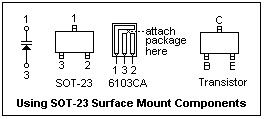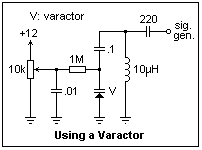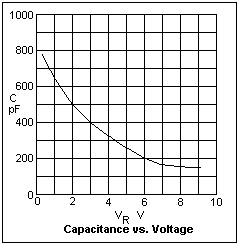The Schottky diode or Schottky Barrier diode is an electronics component that is widely used for radio frequency (RF) applications as a mixer or detector diode.
The Schottky diode is also used in power applications as a rectifier, again because of its low forward voltage drop leading to lower levels of power loss compared to ordinary PN junction diodes. Although normally called the Schottky diode these days, named after Schottky, it is also sometimes referred to as the surface barrier diode, hot carrier diode or even hot electron diode.
Despite the fact that Schottky barrier diodes have many applications in today's high tech electronics scene, it is actually one of the oldest semiconductor devices in existence. As a metal-semiconductor devices, its applications can be traced back to before 1900 where crystal detectors, cat's whisker detectors and the like were all effectively Schottky barrier diodes.
Structure
The Schottky barrier diode can be manufactured in a variety of forms. The most simple is the point contact diode where a metal wire is pressed against a clean semiconductor surface. This was how the early Cat's Whisker detectors were made, and they were found to be very unreliable, requiring frequent repositioning of the wire to ensure satisfactory operation. In fact the diode that is formed may either be a Schottky barrier diode or a standard PN junction dependent upon the way in which the wire and semiconductor meet and the resulting forming process.

Point contact Schottky diode
Although point contact diodes were manufactured many years later, these diodes were also unreliable and they were subsequently replaced by a technique in which metal was vacuum deposited.

Deposited metal Schottky barrier diode
One of the problems with the simple deposited metal diode is that breakdown effects are noticed around the edge of the metalised area. This arises from the high electric fields that are present around the edge of the plate. Leakage effects are also noticed. To overcome these problems a guard ring of P+ semiconductor fabricated using a diffusion process is used along with an oxide layer around the edge. In some instances metallic silicides may be used in place of the metal.

Deposited metal and oxide film Schottky diode
There are a number of points of interest from the fabrication process. The most critical element in the manufacturing process is to ensure a clean surface for an intimate contact of the metal with the semiconductor surface, and this is achieved chemically. The metal is normally deposited in a vacuum either by the use of evaporation or sputtering techniques. However in some instances chemical deposition is gaining some favour, and actual plating has been used although it is not generally controllable to the degree required.
When silicides are to be used instead of a pure metal contact, this is normally achieved by depositing the metal and then heat treating to give the silicide. This process has the advantage that the reaction uses the surface silicon, and the actual junction propagates below the surface, where the silicon will not have been exposed to any contaminants. A further advantage of the whole Schottky structure is that it can be fabricated using relatively low temperature techniques, and does not generally need the high temperature steps needed in impurity diffusion.
Characteristics
The Schottky diode is what is called a majority carrier device. This gives it tremendous advantages in terms of speed because it does not rely on holes or electrons recombining when they enter the opposite type of region as in the case of a conventional diode. By making the devices small the normal RC type time constants can be reduced, making these diodes an order of magnitude faster than the conventional PN diodes. This factor is the prime reason why they are so popular in radio frequency applications.
The diode also has a much higher current density than an ordinary PN junction. This means that forward voltage drops are lower making the diode ideal for use in power rectification applications.
Its main drawback is found in the level of its reverse current which is relatively high. For many uses this may not be a problem, but it is a factor which is worth watching when using it in more exacting applications.
The overall I-V characteristic is shown below. It can be seen that the Schottky diode has the typical forward semiconductor diode characteristic, but with a much lower turn on voltage. At high current levels it levels off and is limited by the series resistance or the maximum level of current injection. In the reverse direction breakdown occurs above a certain level. The mechanism is similar to the impact ionisation breakdown in a PN junction.
Applications
The Schottky barrier diodes are widely used in the electronics industry finding many uses as diode rectifier. Its unique properties enable it to be used in a number of applications where other diodes would not be able to provide the same level of performance. In particular it is used in areas including:
- RF mixer and detector diode
- Power rectifier
- Power OR circuits
- Solar cell applications
- Clamp diode - especially with its use in LS TTL
The use in each of these applications is slightly different, sometimes focussing on different properties of the diode. Accordingly they will be addressed separately.
Schottky diode as an RF mixer and detector diode
The Schottky diode has come into its own for radio frequency applications because of its high switching speed and high frequency capability. In view of this Schottky barrier diodes are used in many high performance diode ring mixers. In addition to this their low turn on voltage and high frequency capability and low capacitance make them ideal as RF detectors.
Schottky diode as a power rectifier diode
Schottky barrier diodes are also used in high power applications, as rectifiers. Their high current density and low forward voltage drop mean that less power is wasted than if ordinary PN junction diodes were used. This increase in efficiency means that less heat has to be dissipated, and smaller heat sinks may be able to be incorporated in the design.
Schottky diode in power OR circuits
Schottky diodes can be used in applications where a load is driven by two separate power supplies. One example may be a mains power supply and a battery supply. In these instances it is necessary that the power from one supply does not enter the other. This can be achieved using diodes. However it is important that any voltage drop across the diodes is minimised to ensure maximum efficiency. As in many other applications, the Schottky diode is ideal for this in view of its low forward voltage drop.
Schottky diodes tend to have a high reverse leakage current. This can lead to problems with any sensing circuits that may be in use. Leakage paths into high impedance circuits can give rise to false readings. This must therefore be accommodated in the circuit design.
Schottky diode in solar cell applications
Solar cells are typically connected to rechargeable batteries, often lead acid batteries because power may be required 24 hours a day and the Sun is not always available. Solar cells do not like the reverse charge applied and therefore a diode is required in series with the solar cells. Any voltage drop will result in a reduction in efficiency and therefore a low voltage drop diode is needed. As in other applications, the low voltage drop of the Schottky diode is particularly useful, and as a result Schottky diodes are normally used in this application.
Schottky diode as a clamp diode
Schottky barrier diodes may also be used as a clamp diode in a transistor circuit to speed the operation when used as a switch. They were used in this role in the 74LS (low power Schottky) and 74S (Schottky) families of logic circuits. Schottky barrier diodes are inserted between the collector and base of the driver transistor to act as a clamp. To produce a low or logic "0" output the transistor is driven hard on, and in this situation the base collector junction in the diode is forward biased. When the Schottky diode is present this takes most of the current and allows the turn off time of the transistor to be greatly reduced, thereby improving the speed of the circuit.

An NPN transistor with Schottky diode clamp
Schottky diode summary
Schottky barrier diodes are used in many areas of electronics because of the properties thay offer. As a result Schottky diodes are used as discrete components for RF and power applications as well as being incorporated within devices as protection devices or for charge removal in devices from photodiodes to MESFETs. Not only do Schottky barrier diodes find widespread use in many applications in its own right, but it an essential part of many other components as well.
Freddy R Vallenilla R
16.791.006
EES SEC 2


 The solution for this problem is offered by the "Surfboards" of Capital Advanced Technologies (p. 752). These are small boards, as shown at the right, with SIP pins (inline pins at 0.1" spacing) and pads suitable for surface-mount devices. Discrete devices, like our SOT-23 diodes, can be easily soldered to the 6000-series Surfboards. The 6103CA, which holds one device, is suitable. The connections are shown at the right. If you buy your Surfboards from Digi-Key, you will get instructions on how to use them. The methods described here can also be used with surface-mount transistors and components, which will also fit on the Surfboards. This seems to be a practical way to use surface-mount devices when you are compelled to do so.
The solution for this problem is offered by the "Surfboards" of Capital Advanced Technologies (p. 752). These are small boards, as shown at the right, with SIP pins (inline pins at 0.1" spacing) and pads suitable for surface-mount devices. Discrete devices, like our SOT-23 diodes, can be easily soldered to the 6000-series Surfboards. The 6103CA, which holds one device, is suitable. The connections are shown at the right. If you buy your Surfboards from Digi-Key, you will get instructions on how to use them. The methods described here can also be used with surface-mount transistors and components, which will also fit on the Surfboards. This seems to be a practical way to use surface-mount devices when you are compelled to do so. The basic circuit for testing a varactor is shown at the right. The key is the 1M resistor that isolates the DC voltage source from the circuit attached to the varactor. The 0.1μF capacitor blocks the DC bias voltage. I happened to have a 10μH inductor at hand, one of those that looks like a fat resistor, and has a reasonably high Q. The RF signal generator was coupled through a 220pF capacitor, and set for an unmodulated output. Because of stray capacitances, we cannot accurately measure the capacitance of the varactor with this circuit, but we can certainly see its action.
The basic circuit for testing a varactor is shown at the right. The key is the 1M resistor that isolates the DC voltage source from the circuit attached to the varactor. The 0.1μF capacitor blocks the DC bias voltage. I happened to have a 10μH inductor at hand, one of those that looks like a fat resistor, and has a reasonably high Q. The RF signal generator was coupled through a 220pF capacitor, and set for an unmodulated output. Because of stray capacitances, we cannot accurately measure the capacitance of the varactor with this circuit, but we can certainly see its action. The results of a series of measurements is shown at the left. The capacitance varied from about 170 pF at 8 V to 750 pF at 0.5V, a satisfactory range. If you plot the frequency vs. the voltage, the result is almost linear, showing that the varactor is of the hyperabrupt type, since n = 2 will give frequency proportional to voltage. I also determined that the MPN3404 that I found in the varactor drawer was probably not a varactor. It was not described, but was listed, in the Motorola data book.
The results of a series of measurements is shown at the left. The capacitance varied from about 170 pF at 8 V to 750 pF at 0.5V, a satisfactory range. If you plot the frequency vs. the voltage, the result is almost linear, showing that the varactor is of the hyperabrupt type, since n = 2 will give frequency proportional to voltage. I also determined that the MPN3404 that I found in the varactor drawer was probably not a varactor. It was not described, but was listed, in the Motorola data book.







